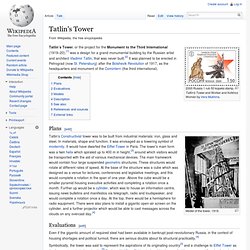

Tatlin's Tower. 2000 Russia 1 rub 50 kopeks stamp.

Tatlin's Tower and Worker and Kolkhoz Woman by Vera Mukhina. Tatlin’s Tower, or the project for the Monument to the Third International (1919–20),[1] was a design for a grand monumental building by the Russian artist and architect Vladimir Tatlin, that was never built.[2] It was planned to be erected in Petrograd (now St. Petersburg) after the Bolshevik Revolution of 1917, as the headquarters and monument of the Comintern (the third international).
Plans[edit] Model of the tower, 1919. Evaluations[edit] Even if the gigantic amount of required steel had been available in bankrupt post-revolutionary Russia, in the context of housing shortages and political turmoil, there are serious doubts about its structural practicality.[4] Models[edit] Model of Tatlin's Tower in the courtyard of the Royal Academy, London. Description[edit] See also[edit] References and sources[edit] References Jump up ^ Honour, H. and Fleming, J. (2009) A World History of Art. 7th edn. Sources. Ben joyce. Ben joyce. BBC Blast - Presentation. Newmindspace. The Arts Map: Connecting Artists and the Community. 15 (More) Creative Works of Steampunk Art and Fashion: From Steam Tanks to Cufflinks. (Check out our complete collection of 100+ Works of Creative and Geeky Art and Graffiti.)

Steampunk art, fashion and culture has far outgrown its roots in retro science fiction, blossoming into an altered image of the distant past, filtered through a dream future world that might have been. Though firmly anchored in a gilded age when technology offered unlimited hope and promise, steampunk has transcended the limits of time and space by melding the modern with the moldering, brass with class, one might say. (image via: Gizmodo) 1999’s Wild Wild West was a film that did much to popularize Steampunk as a legitimate artform and one of the movie’s most iconic images was that of evil Professor Loveless’ gigantic steam-powered spider. Now renowned Steampunk artist Chris Conte has managed to get a leg – actually 8 legs – up on the competition with this supremely creepy Steam-Powered Arachnid. (images via: Geek Alerts) (image via: Tribe) (image via: Alex Holden) (image via: Comicsando)
Hypercube. Un article de Wikipédia, l'encyclopédie libre.

Une projection d'un hypercube (dans une image bidimensionnelle) Un hypercube n-dimensionnel est aussi appelé un n-cube. Le terme « polytope de mesure » (qui est apparemment dû à Coxeter ; voir #Références) est aussi utilisé mais il est rare. Enfin, le cas particulier du 4-cube est souvent désigné par le terme de tesseract. Définition[modifier | modifier le code] Représenter un hypercube de dimension n[modifier | modifier le code] Pour représenter un hypercube de dimension n, on procède comme suit : Dimension 2 : Si on déplace ce segment d'une longueur unité dans une direction perpendiculaire à partir de lui-même ; il balaie un carré bi-dimensionnel.
Dimension 3 : Si on déplace le carré d'une longueur unité dans la direction perpendiculaire à l'emplacement de celui-ci, il engendrera un cube tri-dimensionnel. Dimension n > 3 : On trace un hypercube de dimension n-1, on reproduit son image et on lie les points deux à deux. Le patron d’un hypercube.